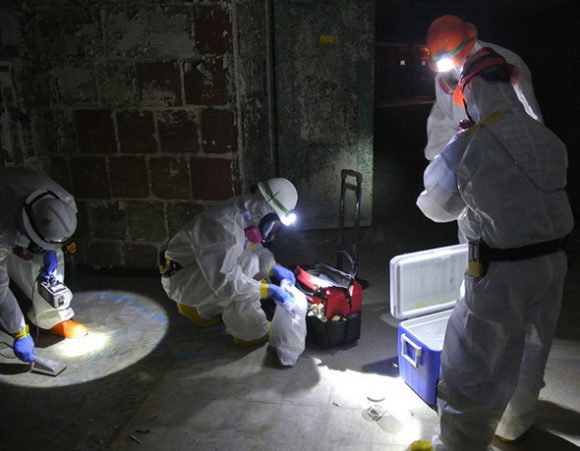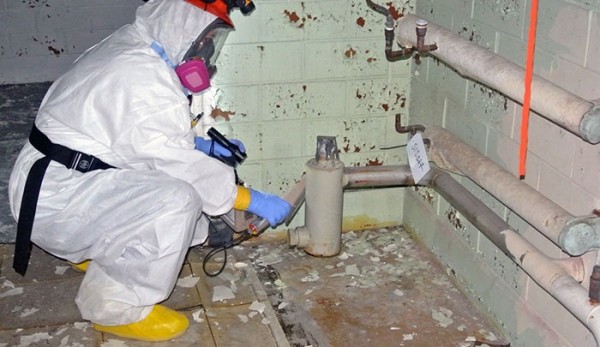
An aerial view of the Biology Complex at the Y-12 National Security Complex. Plans call for eventually demolishing the complex. (Photo courtesy U.S. Department of Energy)
If excess funding is available, the federal cleanup program in Oak Ridge has a top priority: the Biology Complex at the Y-12 National Security Complex.
The budget request submitted to Congress by President Donald Trump on Tuesday, May 23, included $225 million for high-risk excess contaminated facilities at Y-12 and Lawrence Livermore National Laboratory in California.
It’s not clear how much of that money might be used in Oak Ridge, if the president’s budget request were approved. Officials said the allocations would be determined by U.S. Department of Energy headquarters.
But the Oak Ridge cleanup program, known as environmental management, has taken steps to ensure that some projects here, such as the planned demolition of Y-12’s Biology Complex, are “in a good position” if money becomes available.
On Friday, Jay Mullis, acting manager for the DOE Oak Ridge Office of Environmental Management, or EM, said the Biology Complex would be a primary priority if Y-12 gets some portion of the $225 million proposed by the Trump administration.
“Provided there is excess funding, that would be the building we would go after,” the Oak Ridge EM program said.
An energy and water appropriations bill approved by the Senate Appropriations Committee in a 30-1 vote on Thursday includes less money, $55 million, for high-risk, excess facilities at Y-12 and Lawrence Livermore National Laboratory than the $225 million proposed by the Trump administration. But the Senate bill, which hasn’t been approved by the full Senate, designates $40 million of that $55 million for Y-12 cleanup. (See page 103 of this Senate Appropriations report.)
The energy and water appropriations bill approved by the House Appropriations Committee on July 12 specifically recommends $35 million for “nuclear facility cleanup in Oak Ridge to support the demolition of the Y-12 Biology Complex” as part of funding for individual EM sites to “accelerate known demolition projects and initiate new transfers to EM.”
U.S. Senator Lamar Alexander is chair of the Senate Energy and Water Development Appropriations Subcommittee, which first approved the Senate bill, and Representative Chuck Fleischmann is vice chair of the House Energy and Water Subcommittee, which first approved the House bill. Both legislators are Tennessee Republicans, and Fleischmann’s district includes Oak Ridge.
Mullis said the Biology Complex is a priority for the DOE EM program, the DOE Office of Science, and the National Nuclear Security Administration. Y-12 is an NNSA site.
He said a lot of work was done under the American Recovery and Reinvestment Act of 2009, the stimulus package signed into law by President Barack Obama early in his presidency. The Biology Complex originally consisted of 12 buildings, but EM demolished four of them in 2010 as part of the ARRA.
More recently, in April, the Oak Ridge Office of Environmental Management and its cleanup contractor, URS | CH2M, or UCOR, finished characterizing the Biology Complex, identifying contaminants before demolishing and disposing of the buildings.
DOE said it was crucial to get crews into the complex before the working environment became too hazardous.
“Already, team members could not enter a building due to a failed roof,” the Department of Energy said in a story published online in April. “Elsewhere, exterior tiles have fallen from the façade, and asbestos and other material present risks to workers due to roof leaks.”
Mullis said then that the completion of the characterization work sets up the cleanup program to demolish Y-12’s Biology Complex when funds become available.
“Our goal is to eventually take down this 1940s-era complex, which will eliminate safety risks and provide land for Y-12 to continue its important national security missions,” Mullis said.
On Friday, Mullis said many of the hazardous materials have been removed. Although some radiological hazards remain, most of the remaining hazards are industrial hazards such as asbestos, heavy metals, chemicals, and bird and bat droppings, Mullis said. The Biology Complex is a collection of buildings connected by walkways, and parts of the buildings are collapsing, Mullis said.
The characterization work completed in April was part of DOE’s Excess Contaminated Facilities Initiative, an effort to reduce risks and stabilize facilities not scheduled for near-term demolition.
DOE said there are eight remaining Biology Complex buildings of almost 350,000 square feet total. They are owned by DOE’s Office of Science but at Y-12. They have been vacant since the early 2000s.

Crew members prepare samples for shipment to the laboratory for analysis from inside the Biology Complex at Y-12 National Security Complex. (Photo courtesy U.S. Department of Energy)
In April, DOE said the complex’s characterization results showed significant amounts of asbestos and other wastes, such as polychlorinated biphenyls, or PCBs. That’s similar to what has been found at many other facilities built in the 1940s, DOE said. Workers also found radiological constituents in some buildings.
DOE said then that the characterization results verified that six of the buildings could be disposed in the Y-12 sanitary landfills because they do not contain radiological contamination. The remaining two will be disposed in the Environmental Management Waste Management Facility west of Y-12 on Bear Creek Road.
The Biology Complex was originally built to recover uranium from process streams. It later housed DOE’s research on the genetic effects of radiation from the late 1940s. The facilities once housed more individuals with doctorates than anywhere in the world, according to the U.S. Department of Energy.
Mullis said the undetermined portion of the $225 million proposed by the Trump administration for high-risk, excess facilities at Y-12 would be in addition to the $390 million requested for other Oak Ridge cleanup work. That additional work includes continued deactivation and demolition of remaining facilities at East Tennessee Technology Park, continued preparation of Building 2026 to support the processing of the remaining U-233 material at Oak Ridge National Laboratory, and to support activities for the planned Mercury Treatment Facility at Y-12 National Security Complex, among other projects.
It’s not clear what the total funding for Oak Ridge would be, but Mullis said it would be in line with previous years.
“This is in line and actually more supportive of cleanup in Oak Ridge than some of the previous budgets,” Mullis said. “This administration is certainly supportive of cleanup here.”
It’s not clear whether it helped that Sue Cange, a former Oak Ridge cleanup manager, was DOE’s acting EM assistant secretary in Washington, D.C., at the time that the budget was presented to Congress in May.
There is still additional work to do before a funding agreement is reached, including having the House and Senate pass their bills.
For now, DOE is planning to the president’s budget.
More information will be added as it becomes available.

A worker surveys a pipe for contamination inside the Biology Complex at Y-12 National Security Complex. (Photo by the U.S. Department of Energy)
Do you appreciate this story or our work in general? If so, please consider a monthly subscription to Oak Ridge Today. See our Subscribe page here. Thank you for reading Oak Ridge Today.
Copyright 2017 Oak Ridge Today. All rights reserved. This material may not be published, broadcast, rewritten, or redistributed.

Leave a Reply